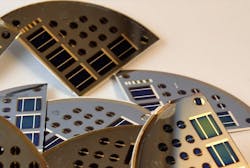ASU research dramatically improves CdTe thin-film solar cell efficiency
Collaboration between researchers within the Ira A. Fulton Schools of Engineering at Arizona State University (ASU; Tempe, AZ) has wedded two previously disparate solar technologies to improve cadmium telluride (CdTe) thin-film solar cells. The research is a new approach to materials science and takes another step toward lower-cost and widely accessible solar power.
RELATED ARTICLE: Lasers speed solar cell production
Research led by electrical engineering professor Yong-Hang Zhang and assistant professor Zachary Holman is detailed in Nature Energy and includes not only breaking an efficiency record with a large margin for monocrystalline CdTe cells, but more importantly, achieving the highest open-circuit voltage ever recorded in this type of solar cell.
Open-circuit voltage is one of the very key factors determining how efficiently electricity can be generated from sunlight by a solar cell—voltage measures the potential for the solar cell to pump electricity around a circuit. High voltage is created when light is absorbed in a solar cell, exciting electrons by shaking them off their atoms. The electrons then build up on one side of the solar cell, like at the negative terminal of a battery.
Engineering a solar cell with high voltage is challenging because the excited electrons can be lost within microseconds or even nanoseconds of sunlight hitting a solar cell. Thus, a goal of solar cell research is to extract the electricity before it dissipates, which is generally accomplished by adding conductive contacts to the top and bottom of a solar cell, according to Zhang. "However, the traditional contacts are made through introducing impurities in the solar cell absorbing layer, which can degrade the device performance dramatically," said Zhang.
To overcome this dilemma, Zhang, Holman and their research teams did not introduce a p-type impurity to the absorber layer but instead added a separate contact layer of low-cost amorphous silicon. In doing so, they've created a solar cell that has a substantially improved capacity with a voltage of 1.1 volt, an unimaginable feat even one year ago. "This was accomplished with the creation of a solar cell using a double heterostructure combined with the novel contact layer design,” said Zhang. "Essentially, we've created a solar cell that allows for the maximum number of electrons possible to build up before extracting them quickly and efficiently out the 'smart' contact."
While attaining this level of voltage is significant, the cells have also reached 17% efficiency, breaking the record of only 15.2% for monocrystalline CdTe solar cells. While other types of solar cells, such as silicon, boast a best efficiency rating of around 25%, such a dramatic improvement in CdTe thin-film solar cells efficiency shows promise for the scaled use of the technology.
While silicon solar panels dominate the market, there are about 10 Gigawatts—enough to power 2.5 million homes—of CdTe solar panels in use worldwide today. In fact, the Tempe, AZ, based First Solar is uniquely positioned to leverage the improved technology as the world's largest manufacturer of thin-film solar cells.
Though Zhang and his group initially conceived the underlying concept of these breakthrough solar cells, it took them more than two years to improve the materials needed to fabricate them. They also called upon Holman's expertise in silicon solar cells to marry two very different semiconductors to achieve these unique and efficient properties.
Initial support for this research came from the Science Foundation Arizona in 2007, and following funding from the National Science Foundation, the Army Research Office, the Air Force Research Laboratory and Air Force Office of Scientific Research have paved the way to enabled many of these new ideas developed in the past 10 years, according to Zhang.
SOURCE: ASU; http://fullcircle.asu.edu/research/new-inventions-asu-researchers-may-lead-cheaper-solar-power/
About the Author

Gail Overton
Senior Editor (2004-2020)
Gail has more than 30 years of engineering, marketing, product management, and editorial experience in the photonics and optical communications industry. Before joining the staff at Laser Focus World in 2004, she held many product management and product marketing roles in the fiber-optics industry, most notably at Hughes (El Segundo, CA), GTE Labs (Waltham, MA), Corning (Corning, NY), Photon Kinetics (Beaverton, OR), and Newport Corporation (Irvine, CA). During her marketing career, Gail published articles in WDM Solutions and Sensors magazine and traveled internationally to conduct product and sales training. Gail received her BS degree in physics, with an emphasis in optics, from San Diego State University in San Diego, CA in May 1986.
